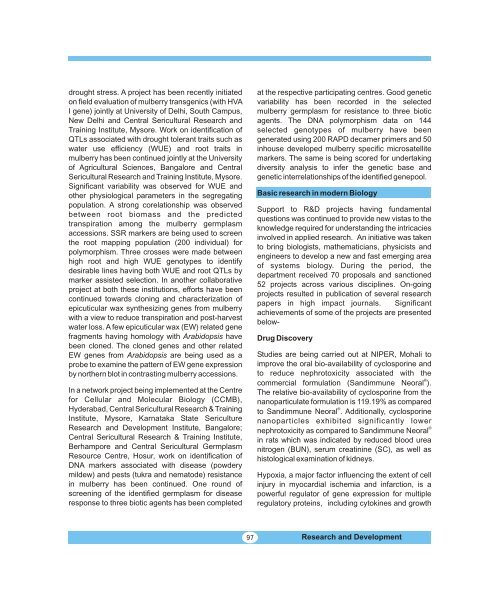ANNUAL REPORT - Department of Biotechnology
ANNUAL REPORT - Department of Biotechnology
ANNUAL REPORT - Department of Biotechnology
Create successful ePaper yourself
Turn your PDF publications into a flip-book with our unique Google optimized e-Paper software.
drought stress. A project has been recently initiated<br />
on field evaluation <strong>of</strong> mulberry transgenics (with HVA<br />
I gene) jointly at University <strong>of</strong> Delhi, South Campus,<br />
New Delhi and Central Sericultural Research and<br />
Training Institute, Mysore. Work on identification <strong>of</strong><br />
QTLs associated with drought tolerant traits such as<br />
water use efficiency (WUE) and root traits in<br />
mulberry has been continued jointly at the University<br />
<strong>of</strong> Agricultural Sciences, Bangalore and Central<br />
Sericultural Research and Training Institute, Mysore.<br />
Significant variability was observed for WUE and<br />
other physiological parameters in the segregating<br />
population. A strong corelationship was observed<br />
between root biomass and the predicted<br />
transpiration among the mulberry germplasm<br />
accessions. SSR markers are being used to screen<br />
the root mapping population (200 individual) for<br />
polymorphism. Three crosses were made between<br />
high root and high WUE genotypes to identify<br />
desirable lines having both WUE and root QTLs by<br />
marker assisted selection. In another collaborative<br />
project at both these institutions, efforts have been<br />
continued towards cloning and characterization <strong>of</strong><br />
epicuticular wax synthesizing genes from mulberry<br />
with a view to reduce transpiration and post-harvest<br />
water loss. A few epicuticular wax (EW) related gene<br />
fragments having homology with Arabidopsis have<br />
been cloned. The cloned genes and other related<br />
EW genes from Arabidopsis are being used as a<br />
probe to examine the pattern <strong>of</strong> EW gene expression<br />
by northern blot in contrasting mulberry accessions.<br />
In a network project being implemented at the Centre<br />
for Cellular and Molecular Biology (CCMB),<br />
Hyderabad, Central Sericultural Research & Training<br />
Institute, Mysore, Karnataka State Sericulture<br />
Research and Development Institute, Bangalore;<br />
Central Sericultural Research & Training Institute,<br />
Berhampore and Central Sericultural Germplasm<br />
Resource Centre, Hosur, work on identification <strong>of</strong><br />
DNA markers associated with disease (powdery<br />
mildew) and pests (tukra and nematode) resistance<br />
in mulberry has been continued. One round <strong>of</strong><br />
screening <strong>of</strong> the identified germplasm for disease<br />
response to three biotic agents has been completed<br />
97<br />
at the respective participating centres. Good genetic<br />
variability has been recorded in the selected<br />
mulberry germplasm for resistance to three biotic<br />
agents. The DNA polymorphism data on 144<br />
selected genotypes <strong>of</strong> mulberry have been<br />
generated using 200 RAPD decamer primers and 50<br />
inhouse developed mulberry specific microsatellite<br />
markers. The same is being scored for undertaking<br />
diversity analysis to infer the genetic base and<br />
genetic interrelationships <strong>of</strong> the identified genepool.<br />
Basic research in modern Biology<br />
Support to R&D projects having fundamental<br />
questions was continued to provide new vistas to the<br />
knowledge required for understanding the intricacies<br />
involved in applied research. An initiative was taken<br />
to bring biologists, mathematicians, physicists and<br />
engineers to develop a new and fast emerging area<br />
<strong>of</strong> systems biology. During the period, the<br />
department received 70 proposals and sanctioned<br />
52 projects across various disciplines. On-going<br />
projects resulted in publication <strong>of</strong> several research<br />
papers in high impact journals. Significant<br />
achievements <strong>of</strong> some <strong>of</strong> the projects are presented<br />
below-<br />
Drug Discovery<br />
Studies are being carried out at NIPER, Mohali to<br />
improve the oral bio-availability <strong>of</strong> cyclosporine and<br />
to reduce nephrotoxicity associated with the<br />
®<br />
commercial formulation (Sandimmune Neoral ).<br />
The relative bio-availability <strong>of</strong> cyclosporine from the<br />
nanoparticulate formulation is 119.19% as compared<br />
®<br />
to Sandimmune Neoral . Additionally, cyclosporine<br />
nanoparticles exhibited significantly lower<br />
®<br />
nephrotoxicity as compared to Sandimmune Neoral<br />
in rats which was indicated by reduced blood urea<br />
nitrogen (BUN), serum creatinine (SC), as well as<br />
histological examination <strong>of</strong> kidneys.<br />
Hypoxia, a major factor influencing the extent <strong>of</strong> cell<br />
injury in myocardial ischemia and infarction, is a<br />
powerful regulator <strong>of</strong> gene expression for multiple<br />
regulatory proteins, including cytokines and growth<br />
Research and Development

















